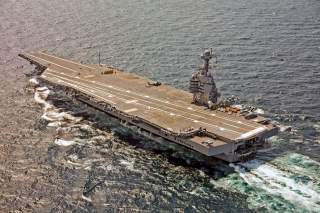The Ford-Class Aircraft Carrier Has Some Serious Issues to Fix
Can it be done?
Oh the problems.
Brand-new Navy aircraft carrier and floating catastrophe USS Gerald R. Ford was forced to return to Naval Station Norfolk in Virginia after encountering issues with its propulsion train, Navy Times reports — the second critical failure in the propulsion system to roil the next-generation supercarrier, after a previously undisclosed failure was initially discovered months ago.
-The engines don’t work. Well, sort of: According to Navy Times, problems “reside in the mechanical components associated in turning steam created by the nuclear plant into spinning screws that power the ship through the water,” although Naval Sea Systems Command spokesman Bill Couch asserted that the new problem was different from an earlier problem identified by the crew in January and publicly disclosed this month. NAVSEA told Bloomberg that shipbuilder Huntington Ingalls identified the issue as a “manufacturing defect” rather than an overall design flaw.
-This is what testing is supposed to accomplish. Sure, the headlines sound bad, but naval warfare reporter Chris Cavas rightfully points out that these errors turn up all the time in pre-service shakedown; indeed, the Associated Press notes that the Ford was expected to steam to the Newport News in July to fix any existing technical issues, of which there are many.“Ford has been tasked with conducting critical test and evaluation operations that identify construction and design issues,” NAVSEA spokesman Colleen O’Rourke told Navy Times. “As a continuation of that testing and evaluation process, Ford got underway to conduct an independent steaming event that would allow the ship and its crew to continue testing its systems and procedures.”
-Yet another issue… News of the Ford’s propulsion issues comes months after an intensive assessment, conducted by the Office of the Director of Operational Test and Evaluation and published in January, revealed a slew of technical problems plaguing the Pentagon’s first new carrier design in nearly four decades. Those problems included “poor or unknown reliability” among critical systems and, most embarrassingly, inconsistencies with that brand-new “digital” Electromagnetic Aircraft Launching System (EMALS) that President Donald Trump railed against last year.
-… and bad timing: Even if the Ford’s myriad issues are worked out through the Navy’s standard testing evaluation protocol, news of the propulsion issues couldn’t have emerged at a worse time for the service. NAVSEA announced on May 11 that the Navy would have to shell out an additional $120 million for the carrier, bringing its total cost to around $13.03 billion — well above the $12.9 billion cap set by Congress back in April. It doesn’t help that the Navy is currently pushing lawmakers to expedite the purchase of a fourth Ford-class aircraft carrier.
This article originally appeared at Task & Purpose. Follow Task & Purpose on Twitter.
More Articles from Task & Purpose:
- 7 Veteran-Friendly Manufacturers That Are Hiring
- The 6 Types Of Contractors You Encounter Overseas
- Here’s How Marines Fared On The New Physical Fitness Test
Image: Wikimedia

